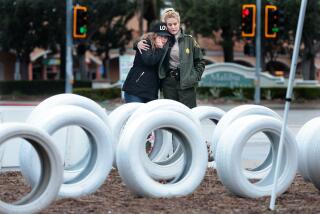HUNTINGTON BEACH : Phase One of River Project Celebrated
Along the windy bank of the Santa Ana River near Pacific Coast Highway, local, state and federal officials Thursday celebrated the completion of the first phase of a long-awaited project to provide increased flood protection for Orange County.
Board of Supervisors Chairman Harriett M. Wieder, who referred to the completion as the “end of the beginning,” and other officials cut a ceremonial ribbon of red, white and blue balloons that stretched 450 feet across the swift-flowing river.
“As a public policy-maker, you help provide for future generations, and you’re never sure you’re going to be there to see it because the democratic process is so slow,” said Wieder, who, in 1975 as a Huntington Beach councilwoman, chaired the committee that helped get the $1.4-billion flood-control project off the ground.
“I wasn’t sure this was going to be in my lifetime,” she said. “Eighteen years ago, I would’ve never dreamed this.”
Wieder said the completion is the first step in providing the county protection from a catastrophic flood.
“I don’t think people (realize) the significance of this project and the security to the future of their lives and homes,” she said.
The completed work stretches 2.7 miles between Pacific Coast Highway to just south of Adams Avenue through the cities of Huntington Beach, Costa Mesa and Newport Beach.
The phase just completed is part of the Santa Ana River Mainstem Flood Control Project to increase flood protection for more than 3 million people in Orange, Riverside and San Bernardino counties.
Improvements to the Santa Ana River, funded with money from the federal government and the three counties, are planned to continue upstream to just below Prado Dam on the eastern outskirts of Orange County. The project is expected to be completed in the year 2000.
Cost of the first phase, which started in April, 1991, was $43 million, said Edward Andrews, Army Corps of Engineers project manager on the lower Santa Ana River project. Andrews said the improvements more than doubled the water capacity of the river channel.
Other improvements included reconstruction of the Greenville-Banning Channel, which runs along the east side of the river from the San Diego Freeway south to Victoria Street in Costa Mesa.
In addition, 92 acres of salt marsh just upstream from Pacific Coast Highway were restored and a six-acre island was created for the endangered California least tern, a small sea bird that nests on the ground.
More to Read
Sign up for Essential California
The most important California stories and recommendations in your inbox every morning.
You may occasionally receive promotional content from the Los Angeles Times.










